The serine protease prostasin (PRSS8) is a potential biomarker for early detection of ovarian cancer
- PMID: 27036110
- PMCID: PMC4815131
- DOI: 10.1186/s13048-016-0228-9
The serine protease prostasin (PRSS8) is a potential biomarker for early detection of ovarian cancer
Abstract
Background: Ovarian cancer (OVC) is the deadliest of all gynecologic cancers, primarily as a consequence of asymptomatic progression. The complex nature of OVC creates challenges for early detection, and there is a lack of specific and sensitive biomarkers suitable for screening and detecting early stage OVC.
Methods: Potential OVC biomarkers were identified by bioinformatic analysis. Candidates were further screened for differential expression in a library of OVC cell lines. OVC-specific overexpression of a candidate gene, PRSS8, which encodes prostasin, was confirmed against 18 major human cancer types from 390 cancer samples by qRT-PCR. PRSS8 expression profiles stratified by OVC tumor stage-, grade- and subtype were generated using cDNA samples from 159 OVC samples. Cell-specific expression and localization of prostasin was determined by immunohistological tissue array analysis of more than 500 normal, benign, and cancerous ovarian tissues. The presence of prostasin in normal, benign, and OVC serum samples was also determined.
Results: Gene expression analysis indicated that PRSS8 was expressed in OVC at levels more than 100 fold greater than found in normal or benign ovarian lesions. This overexpression signature was found in early stages of OVC and was maintained in higher stages and grades of OVC. The PRSS8 overexpression signature was specific for OVC and urinary bladder cancer among 18 human cancer types. The majority of ovarian cell lines overexpressed PRSS8. In situ hybridization and histopathology studies of OVC tissues indicated that overexpression of prostasin was largely localized to tumor epithelium and was absent in neighboring stroma. Significantly higher levels of prostasin were found in early stage OVC serum samples compared to benign ovarian and normal donor samples.
Conclusions: The abundant amounts of secreted prostasin found in sera of early stage OVC can potentially be used as a minimally invasive screening biomarker for early stage OVC. Overexpression of PRSS8 mRNA and high levels of prostasin in multiple subtypes of early stage ovarian tumors may provide clinical biomarkers for early detection of OVC, which can potentially be used with CA125 and HE4.
Keywords: Biomarkers; Diagnostic; Early detection; Ovarian cancer; PRSS8; Prostasin; Serum.
Figures
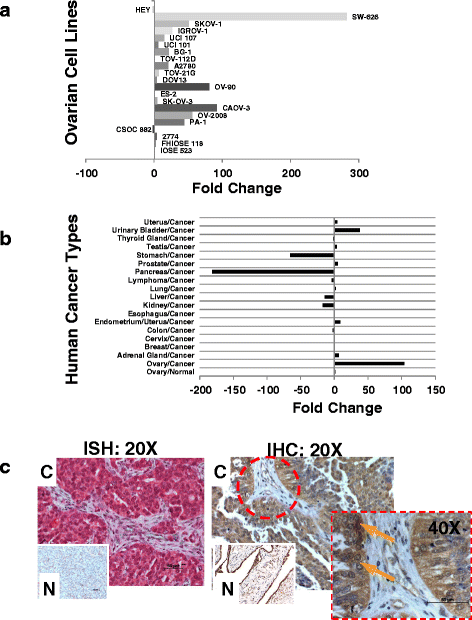
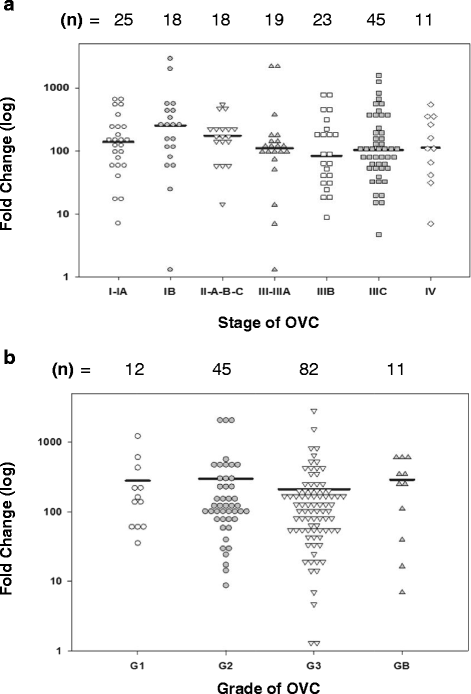
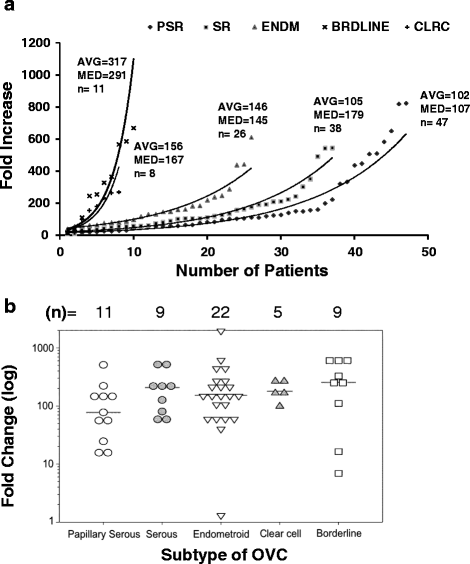
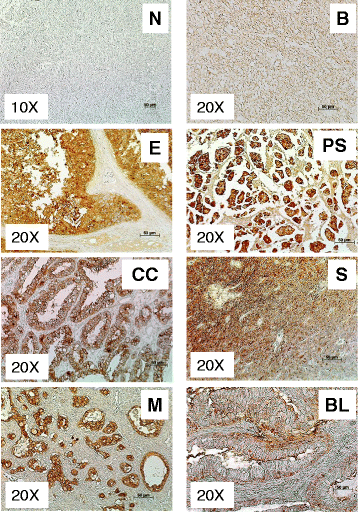
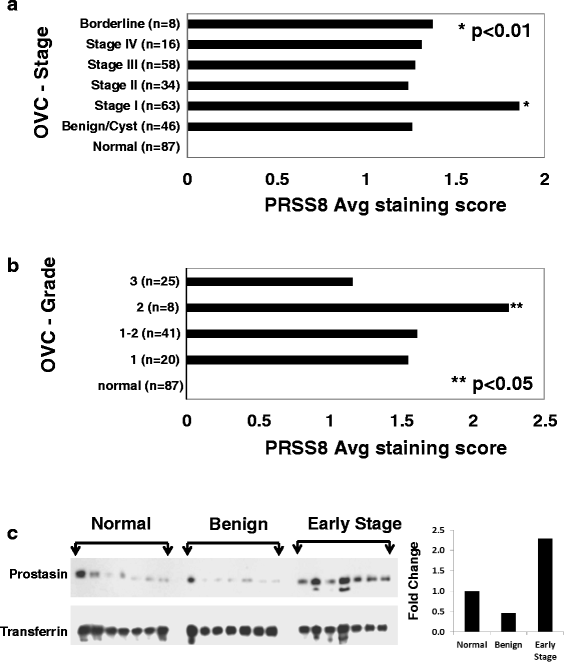
Similar articles
-
Prostasin, a potential serum marker for ovarian cancer: identification through microarray technology.J Natl Cancer Inst. 2001 Oct 3;93(19):1458-64. doi: 10.1093/jnci/93.19.1458. J Natl Cancer Inst. 2001. PMID: 11584061
-
Prostasin, a potential tumor marker in ovarian cancer--a pilot study.Clinics (Sao Paulo). 2009;64(7):641-4. doi: 10.1590/S1807-59322009000700006. Clinics (Sao Paulo). 2009. PMID: 19606239 Free PMC article.
-
Kallikrein family proteases KLK6 and KLK7 are potential early detection and diagnostic biomarkers for serous and papillary serous ovarian cancer subtypes.J Ovarian Res. 2014 Dec 5;7:109. doi: 10.1186/s13048-014-0109-z. J Ovarian Res. 2014. PMID: 25477184 Free PMC article.
-
[Prostasin (PRSS8) as a new pathological factor].Nihon Rinsho. 2015 Mar;73(3):523-33. Nihon Rinsho. 2015. PMID: 25812384 Review. Japanese.
-
Early detection of ovarian cancer.Dis Markers. 2007;23(5-6):397-410. doi: 10.1155/2007/309382. Dis Markers. 2007. PMID: 18057523 Free PMC article. Review.
Cited by
-
Biomarkers in Ovarian Cancer: Towards Personalized Medicine.Proteomes. 2024 Mar 18;12(1):8. doi: 10.3390/proteomes12010008. Proteomes. 2024. PMID: 38535506 Free PMC article. Review.
-
The cell-surface serine protease prostasin is lost during cervical squamous cell carcinogenesis.Hum Cell. 2025 Aug 19;38(5):147. doi: 10.1007/s13577-025-01279-8. Hum Cell. 2025. PMID: 40828246
-
Salivary Chemical Barrier Proteins in Oral Squamous Cell Carcinoma-Alterations in the Defense Mechanism of the Oral Cavity.Int J Mol Sci. 2023 Sep 4;24(17):13657. doi: 10.3390/ijms241713657. Int J Mol Sci. 2023. PMID: 37686462 Free PMC article.
-
Knocking down Sterol regulatory element binding protein 2 (SREBF2) inhibits the Serine Protease 8 (PRSS8) /sodium channel epithelial 1alpha subunit (SCNN1A) axis to reduce the cell proliferation, migration and epithelial-mesenchymal transformation of ovarian cancer.Bioengineered. 2021 Dec;12(2):9390-9400. doi: 10.1080/21655979.2021.1978615. Bioengineered. 2021. PMID: 34823420 Free PMC article.
-
A two-step strategy for identification of plasma protein biomarkers for endometrial and ovarian cancer.Clin Proteomics. 2018 Dec 1;15:38. doi: 10.1186/s12014-018-9216-y. eCollection 2018. Clin Proteomics. 2018. PMID: 30519148 Free PMC article.
References
Publication types
MeSH terms
Substances
LinkOut - more resources
Full Text Sources
Other Literature Sources
Medical
Research Materials
Miscellaneous

